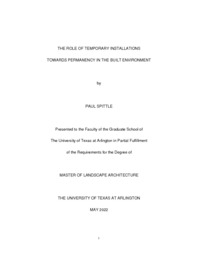| dc.description.abstract | Heralding a new wave against “business-as-usual” planning, design and development practice that had in part brought about the Global Crash of 2008 (Marcinkoski, 2016), the rise in rapid and temporary design typologies, like Park(ing) Day or Better Block (CNU Next Gen, 2010), suggested a new direction that recognized that if you wanted to make a positive change in the built environment, it was easier to act first and apologize afterwards (Lydon et al, 2012). Taking the responsibility of living in the city into their own hands, a new guard of designers looked to the unfinished skeletons of civic construction to open up possibilities, test scenarios and subvert preconceptions of what our cities should be like, and how we should behave in them.
Set against the backdrop of catastrophic civic public space development (Kunstler, 2003), the research investigates the rise of temporary installations (such as Tactical Urbanism) over the last decade, and its current state of practice within allied design fields, accessing whether these short-term temporary solutions are a viable mechanism for long term “place making” (Casey, 1996). The research specifically focuses on understanding landscape architecture’s position in this arena.
The research primarily uses qualitative techniques (Deming & Swaffield, 2011), adopting a three-step procedure to assess temporary installations within the context of landscape architecture practice. First it conducts a comprehensive review of the literature amongst design and planning fields to understand the state of temporary installations in landscape architecture. Then, using convenience sampling methods, researcher selects nine temporary projects across the globe for in-depth evaluation with secondary data. Where possible, post-occupancy evaluation methods are also utilized to assess the impact on long term place-making in subset of cases (Marcus & Francis, 1998). Lastly, semi-structured interviews with professionals, often intimately connected to the case studies, are used to test the evaluation results. Data findings were analyzed using a Grounded Theory approach (Strauss & Corbin, 1990) and common themes are drawn in response to the pursued research questions.
In conclusion, this research reveals that despite its detractors suggesting temporary installations being just a cover up for failing governments (Minkjan & Boer, 2016), this does prove to be a preferred method of generating long term positive change (Kent & Nikitin, 2011). Permanency, in this regard, offers two alternate perspectives; not just in long-standing of site, but also as permanently reshaping the perception of local identity and place (Reynolds in interview, Spittle 2019), and that it is difficult to get to long-term placemaking thinking without the use of temporary installations (Lydon in interview, Spittle, 2019). It is this researcher’s view that short-lived projects can remedy existing urban norms, activating not just those landscapes in transition, but also the public imagination. This research also reveals that the role of landscape architecture can be significant in contrast to the success of those in the allied fields of architecture and planning. | |


